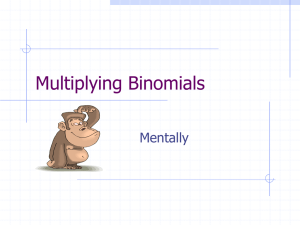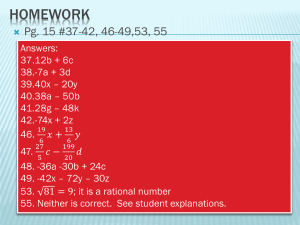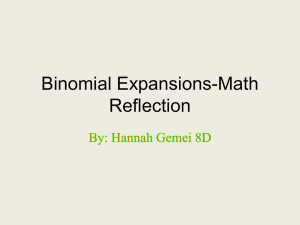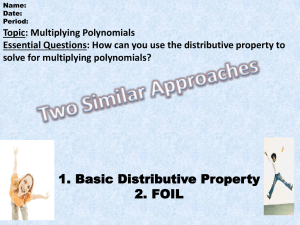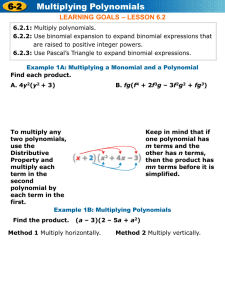DOC - EduGAINS
advertisement
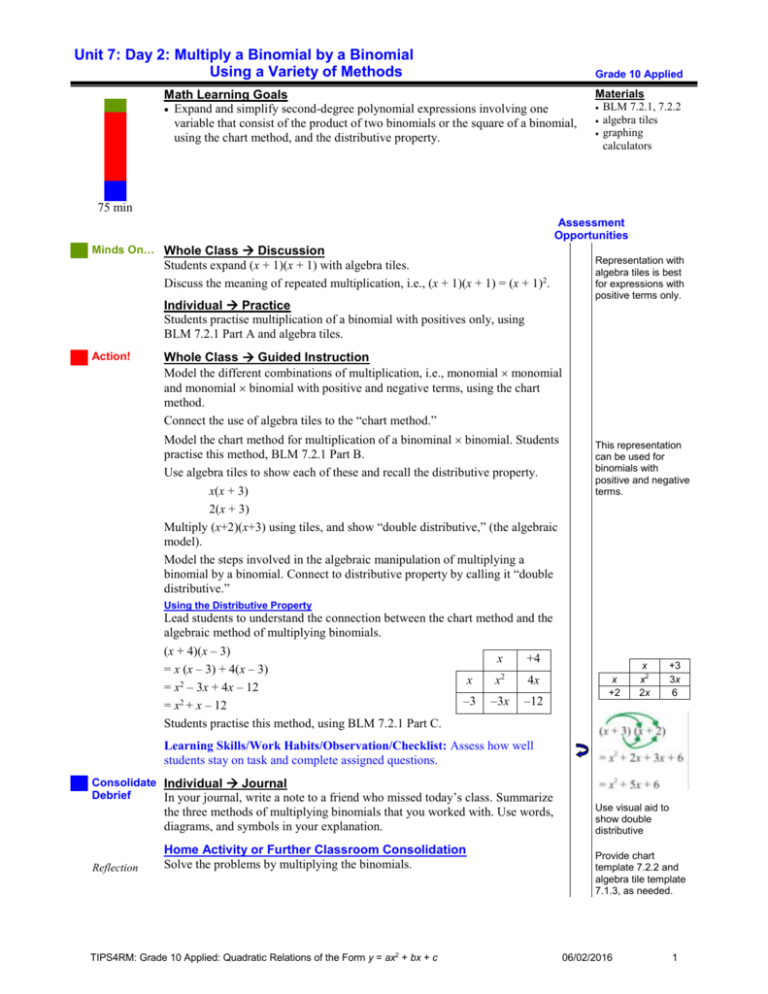
Unit 7: Day 2: Multiply a Binomial by a Binomial Using a Variety of Methods Grade 10 Applied Math Learning Goals Expand and simplify second-degree polynomial expressions involving one variable that consist of the product of two binomials or the square of a binomial, using the chart method, and the distributive property. Materials BLM 7.2.1, 7.2.2 algebra tiles graphing calculators 75 min Assessment Opportunities Minds On… Whole Class Discussion Students expand (x + 1)(x + 1) with algebra tiles. Discuss the meaning of repeated multiplication, i.e., (x + 1)(x + 1) = (x + 1)2. Individual Practice Students practise multiplication of a binomial with positives only, using BLM 7.2.1 Part A and algebra tiles. Action! Representation with algebra tiles is best for expressions with positive terms only. Whole Class Guided Instruction Model the different combinations of multiplication, i.e., monomial monomial and monomial binomial with positive and negative terms, using the chart method. Connect the use of algebra tiles to the “chart method.” Model the chart method for multiplication of a binominal binomial. Students practise this method, BLM 7.2.1 Part B. Use algebra tiles to show each of these and recall the distributive property. x(x + 3) 2(x + 3) Multiply (x+2)(x+3) using tiles, and show “double distributive,” (the algebraic model). Model the steps involved in the algebraic manipulation of multiplying a binomial by a binomial. Connect to distributive property by calling it “double distributive.” This representation can be used for binomials with positive and negative terms. Using the Distributive Property Lead students to understand the connection between the chart method and the algebraic method of multiplying binomials. (x + 4)(x – 3) x +4 = x (x – 3) + 4(x – 3) 2 x x 4x = x2 – 3x + 4x – 12 –3 –3x –12 = x2 + x – 12 Students practise this method, using BLM 7.2.1 Part C. x +2 x x2 2x +3 3x 6 Learning Skills/Work Habits/Observation/Checklist: Assess how well students stay on task and complete assigned questions. Consolidate Individual Journal Debrief In your journal, write a note to a friend who missed today’s class. Summarize the three methods of multiplying binomials that you worked with. Use words, diagrams, and symbols in your explanation. Reflection Home Activity or Further Classroom Consolidation Solve the problems by multiplying the binomials. TIPS4RM: Grade 10 Applied: Quadratic Relations of the Form y = ax2 + bx + c Use visual aid to show double distributive Provide chart template 7.2.2 and algebra tile template 7.1.3, as needed. 06/02/2016 1 Unit 7: Day 2: Multiply A Binomial By A Binomial Using A Variety of Methods (A) Grade 10 Applied Mathematical Process Goals Make connections between finding the product of two binomials and multiplying two 2-digit numbers. Make connections between the chart method and the distributive property. Materials BLM 7.2.1(A), 7.2.2(A), 7.2.3(A) algebra tiles base ten materials 75 min Assessment Opportunities Minds On… Whole Class Discussion Compare the result of multiplying 11 11 using base 10 material so that students understand why the result of (x + 1)(x + 1) is not x2 + 12. Also connect 11 11 = 112 with (x + 1)(x + 1) = (x + 1)2 . Individual Practice Students practise multiplication of a binomial with positives only using algebra tiles and base 10 materials (BLM 7.2.1(A) Part A). Mathematical Process Focus: Connecting See TIPS4RM Mathematical Processes package p. 8 Refer to TIPS4RM Unit 7 Day 1 for base 10 material set up. Action! Whole Class Guided Instruction Guide students to see the connection among algebra tiles, the chart method for multiplication of a binominal binomial, and multiplying two 2-digit numbers. Students include this connection in Part B of BLM 7.2.1A. Using the Distributive Property Demonstrate how a 2-digit number can be expressed as a two-term expression then lead students through the multiplication of two 2-digit numbers using the chart method and then the algebraic method for multiplying two binomials. Emphasize the connections between the two methods. Consolidate Individual Journal Debrief In your journal, write a note to a friend who missed today’s class. Summarize the three methods of multiplying binomials that you worked with and show the connection to multiplying two 2-digit numbers. Use words, diagrams, and symbols in your explanation. Possible guiding questions: What connection do you see between a problem you did previously and today’s problem? What connections do you see between using algebra tiles, an area model, a chart method, or base ten materials to multiply? When could this procedure be used in daily life? To multiply 13 12: 10 +3 10 100 30 +2 20 6 13 12 = (10 + 3)(10 + 2) = 100 + 20 + 30 + 6 = 156 To multiply 14 7 10 +4 10 100 40 –3 –30 –12 14 7 = (10 + 4)(10 – 3) = 100 – 30 + 40 – 12 = 98 Mathematical Process/Connecting/Checklist: Assess how well the students communicate their understanding of how the concepts are connected. Concept Practice Home Activity or Further Classroom Consolidation Solve the problems by multiplying the binomials, including multiplication of two 2-digit numbers, using the chart method on worksheet 7.2.2(A) Grade 10 Applied Unit 4 Adjusted Lesson: Mathematical Processes – Connecting See BLM 7.2.3 (A) for answers 06/02/2016 2 7.2.1(A): Multiply a Binomial by a Binomial Name: Part A Use algebra tiles to multiply and simplify each of the following binomial products. Include an equivalent area model diagram for each to show the multiplication of two 2-digit numbers, with x = 10. 1. y = (x + 1)(x + 3) = _________________ 2. y = (x + 2)(x + 3) = ________________ 11 13 area model diagram: 12 13 area model diagram: Part B Use the chart method to multiply and simplify each of the following binomial products, Complete an equivalent chart for each to show the multiplication of two 2-digit numbers, with x = 10. 1. y = (x + 1)(x + 3) = __________________ 2. y = (x + 2)(x +3) = _________________ 11 13 12 13 10 1 10 10 10 3 3 Grade 10 Applied Unit 7 Adjusted Lesson: Mathematical Processes – Connecting 2 06/02/2016 3 7.2.1(A): Multiply a Binomial by a Binomial (continued) 3. y = (x + 2)(x – 1) = __________________ 4. y = (x – 2)(x + 3) = _________________ 12 9 8 13 10 2 10 10 10 –1 3 –2 5. y = (x – 1)(x – 1) = __________________ 6. y = (x – 1) (x – 2) = _________________ ___ ___ ___ ___ Grade 10 Applied Unit 7 Adjusted Lesson: Mathematical Processes – Connecting 06/02/2016 4 7.2.2(A): Multiply a Binomial by a Binomial Part C Multiply and simplify the two binomials, using the chart method and the distributive property. 1. (x + 4)(x – 3) x +4 2. (x – 3)(x – 3) x +2 4. (x + 2)(x – 1) x +2 5. (x – 2) (x + 1) x +2 x –1 x –3 x –1 x –2 6. (x – 1)2 x –1 x +1 7. (x – 1)(x – 2) –3 x –3 x –3 3. (x + 2)2 x x –1 8. (x – 3)(x – 4) x –2 Grade 10 Applied Unit 7 Adjusted Lesson: Mathematical Processes – Connecting x –4 06/02/2016 5 7.2.3(A): Multiply a Binomial by a Binomial (Teacher) Answers to Part B 1. y = x2 + 4x + 3 x 3 4. x x2 3x 1 x 3 y = x2 + x – 6 x 2. y = x2 + 5x+ 6 x 3 5. x x2 3x 2 2x 6 y = x2 –2x + 1 –2 x –1 2 x x –2x x x –x 3 3x –6 –1 –x 1 2 3. y = x2 + x – 2 x –1 6. x x2 –x 2 2x –2 y = x2 – 3x +2 x x –1 x2 –x –2 –2x 2 Answers to Part C 1. x2 + x – 12 2. x2 – 6x + 9 3. x2 + 4x + 4 4. x2 + x – 2 5. x2 – x – 2 6. x2 – 2x + 1 7. x2 – 3x + 2 8. x2 – 7x + 12 Grade 10 Applied Unit 7 Adjusted Lesson: Mathematical Processes – Connecting 06/02/2016 6
